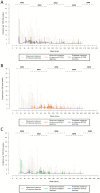Rotavirus seasonality and age effects in a birth cohort study of southern India
- PMID: 23977089
- PMCID: PMC3745434
- DOI: 10.1371/journal.pone.0071616
Rotavirus seasonality and age effects in a birth cohort study of southern India
Erratum in
- PLoS One. 2014;9(1). doi:10.1371/annotation/2f5b6cf8-926b-4397-9a89-64544cc7d512
Abstract
Introduction: Understanding the temporal patterns in disease occurrence is valuable for formulating effective disease preventive programs. Cohort studies present a unique opportunity to explore complex interactions associated with emergence of seasonal patterns of infectious diseases.
Methods: We used data from 452 children participating in a birth cohort study to assess the seasonal patterns of rotavirus diarrhea by creating a weekly time series of rotavirus incidence and fitting a Poisson harmonic regression with biannual peaks. Age and cohort effects were adjusted for by including the weekly counts of number of children in the study and the median age of cohort in a given week. Weekly average temperature, humidity and an interaction term to reflect the joint effect of temperature and humidity were included to consider the effects of meteorological variables.
Results: In the overall rotavirus time series, two significant peaks within a single year were observed--one in winter and the other in summer. The effect of age was found to be the most significant contributor for rotavirus incidence, showing a strong negative association. Seasonality remained a significant factor, even after adjusting for meteorological parameters, and the age and cohort effects.
Conclusions: The methodology for assessing seasonality in cohort studies is not yet developed. This is the first attempt to explore seasonal patterns in a cohort study with a dynamic denominator and rapidly changing immune response on individual and group levels, and provides a highly promising approach for a better understanding of the seasonal patterns of infectious diseases, tracking emergence of pathogenic strains and evaluating the efficacy of intervention programs.
Conflict of interest statement
Figures






References
Publication types
MeSH terms
Grants and funding
LinkOut - more resources
Full Text Sources
Other Literature Sources
Medical

